Below I refer to John Sayles but maybe the movie Mumford is more like Lasse Hallstrom amused and charmed by a Norman Rockwell America. Whatever it is, and despite a few anachronisms, I still find this movie appealing. It has so many actors in it I’ve always liked. Part of its appeal may be that we don’t often see ensemble pieces like this anymore.
The tall tale of The Mexican
Call it a tall tale, a shaggy dog story or any of the other variations, this is a movie that uses exaggeration and fable to tell a story that centres around another romantic tall tale. And it works much better now, ten or more years later, with distance from the marketing and celebrity media atmosphere that surrounded it when released.
The Male Animal is one peculiar movie
Relationships, sex, communists and, somewhere off camera ,World War II — The Male Animal from 1942 is a curious film to say the least. It comes with some pretty impressive credentials, however, including its stars as well as its origins: based on a play by James Thurber and a screenplay with writers that included the Epstein brothers.
How and why Nick and Nora work
The series of Thin Man movies answers the question, “What does happily ever after look like?”
Restraint, Mr. Allison
At the end of this I make an admission — but why wait? I prefer Heaven Knows, Mr. Allison to the better known The African Queen, two movies from the same director (John Huston) and superficially similar. I like this movie and always have. But be warned! It’s a quiet one; it’s characterized by restraint.
Subversive Preston Sturges and Morgan’s Creek
Eddie Bracken just looks funny. It’s not in a physically distorted way; it has something to do with the innocent, cherubic quality of his face that makes you smile. And when he starts moving? You start to laugh.
When style beats the pants off of story
Among the many fascinating and, in this case, amazing things about The Maltese Falcon is that it was the first film for Sydney Greenstreet who was 62 years old at the time. Can you imagine any actor today getting a role, much less starting a career at 62?
Loving and hating Mouse Hunt
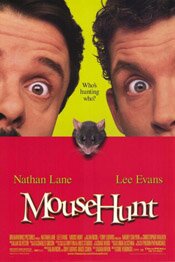 Mousehunt (1997) is a funny movie in both senses of the word. It is funny “ha ha,” and it is funny peculiar.
Mousehunt (1997) is a funny movie in both senses of the word. It is funny “ha ha,” and it is funny peculiar.
For me, it is one of the funniest movies I’ve seen. Ever. I can’t think of many movies, if any, that have made me laugh out loud like this one does.
Other people, however, either like it as I do or absolutely hate it. There is no middle ground. I don’t think I’ve met anyone that felt it was “okay” or “not that good.”
They love it. Or, they hate it.
I suspect it is because the humour is so broad and slapstick. Though there is also some very funny dialogue, it is very visual humour. To an extent, it could be compared to the Three Stooges — at least as far as the visual jokes go.
Oddly, though I love Mousehunt I’ve never been a big fan of the Stooges.
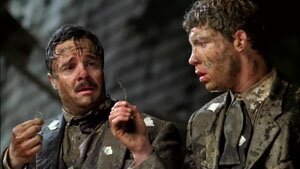
Nathan Lane and Lee Evans are two brothers, Ernie and Lars Smuntz. They inherit a dilapidated house when their father dies along with a string factory that desperately needs modernization. The brothers don’t always agree. One reason is that Lars is simple and kind, for the most part, whereas Ernie is cynical and self-centred.
It’s decided (thanks to Ernie) that they will fix the house up, at least superficially, and then sell it quickly to get whatever they can for it. Then they find out it has historical significance — it’s “the missing Larue,” designed by a famous architect — and worth boatloads of money. They’re thrilled, however …
There is a mouse living in the house and it has other ideas.
As Ernie says later in the movie, after numerous painful attempts to get rid of the mouse, “He’s Hitler with a tail. He’s “The Omen” with whiskers. Even Nostradamus didn’t see him coming!”
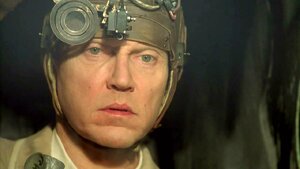
The movie builds from one attempt to another, each more elaborate, each with a more disastrous result. There is one sequence when the brothers bring in ‘Caeser, the Exterminator’ (Christopher Walken) to rid the house of the mouse that is hilarious. Walken gives wonderfully oddball performance as Caesar.
But it’s Lee Evans as Lars that really stands out for me. Tall and gangly, he contorts his body amazingly as he delivers the slapstick humour in a brilliantly visual fashion. Onscreen, he and Nathan Lane make for a tremendous comedy team.
The movie also has a Tim Burton-like look to it; there is a distorted (as in alternately distended and extended), cartoon-ish feel to some of the sets, some camera angles and certain action sequences. The humour is not Tim Burton-like, however. It’s much more direct. It makes no effort at subtlety. That may be why it works so well.
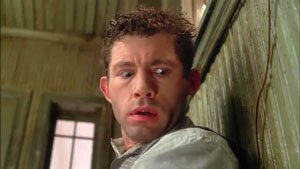
Mousehunt was the first full length movie directed by Gore Verbinski, best known now for his Pirates of the Caribbean movies. He has also directed The Mexican (2001) and The Weather Man (2005). Though quite different movies (especially Weather Man) it strikes me that humour is a key element running through his films and of those he experiments with in the sense that Mousehunt is slapstick, Weather Man satire of a dark variety, and Pirates somewhere between.
Whatever the case, I think it’s safe to say you’ll either love or hate Mousehunt. You have to watch it first, however, to find out which.
Lily Damita, Roland Young and This is the Night
Without intending to, I caught This is the Night on TCM last night and I was delightfully surprised. It was funny, curious and also interesting historically in that it was the first full feature movie Cary Grant ever appeared in. It was directed by Frank Tuttle, a man I know best for having directed This Gun For Hire that starred Veronica Lake.
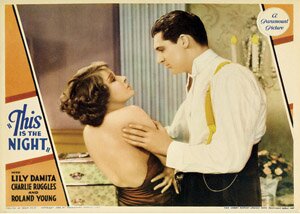 This is the Night (1932)
This is the Night (1932)
Directed by Frank Tuttle
To get the Cary Grant aspect out of the way, you can tell it’s an initial effort. His performance is good sporadically. Often he overplays it, though in one way it works because the film is a farce. You can see, however, the beginnings of what he would later become, especially his comedic skills.
But this movie is really Lily Damita’s and Roland Young’s. (The movie also stars Charles Ruggles and Thelma Todd.)
An athlete (Grant) returns from the Olympics. While he was away, his wife (Todd) has been involved with another man. As that other man, Roland Young must try to cover up the affair. With the help of a friend, Ruggles, he hires a heavily accented actress (Damita) to pretend she’s his wife.
It’s a relationship comedy – quite a funny one – and it is filled with sexual jokes. (The movie was made pre-Code.) For example, a recurring joke in the movie involves Todd whose dress keeps getting removed accidently by the chauffeur/butler. There are verbal jokes as well, such as Damita’s character who doesn’t understand English well, and ends up interpreting hints as, “I live in sin. I am naughty,” when Young tries to tell her to say she’s from Cincinnati.
It’s silly, yes, but lots of fun. It’s not exactly a screwball comedy; it’s a bit too farcical for that. But you can see the beginnings of screwball (just as you can see lingering hints of the silent era in the visual humour, as mentioned in this review).

What I found curious, and a little off-putting, was what I initially thought was a technical mistake in the broadcast but later saw was deliberate. It was this: much of the film occurs in Venice and much of that is at night. Every time the action occurs outside, at night, the screen goes blue.
Yes, it’s a colour that suggests night but in a movie that is otherwise black and white it’s a jarring and unnecessary effect. A quick online look revealed no reference to this so I don’t know if this was something the original movie tried or was added later. But I do know I would remove the effect.
Apart from that, This is the Night is a very fun and funny movie; it even has some nice romantic elements, not to mention Cary Grant’s movie debut. I was glad I found it.
As an aside, Cary Grant would work with Roland Young again a few years later in the movie Topper (1937).
As another aside, Lily Damita was married to Errol Flynn for a number of years and later married to Michael Curtiz. Her Hollywood career was relatively brief. She essentially got out of acting in movies when she married Flynn.


